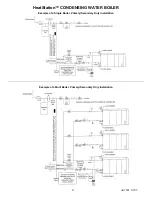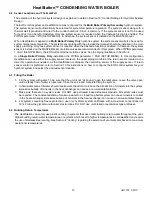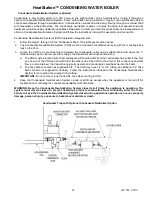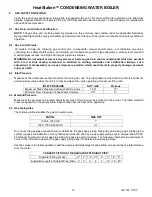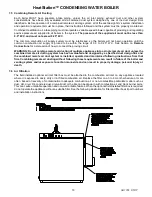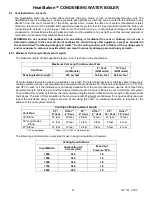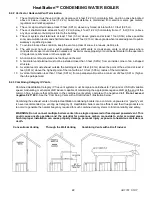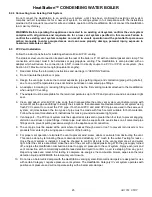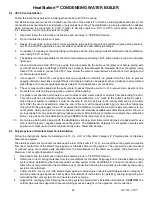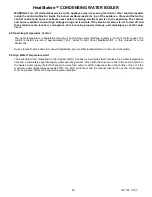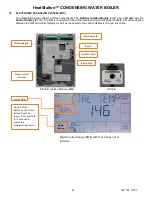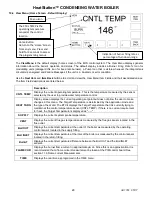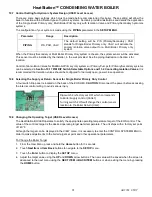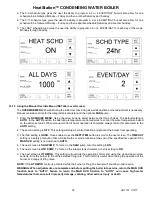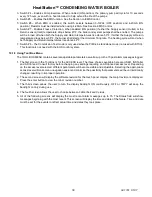
HeatStation™ CONDENSING WATER BOILER
24
34-1161 05/17
8.4 CPVC Vent Installation
Follow the instructions below for installing schedule 40 solid CPVC venting:
The stainless steel vent connection located near the rear of the boiler is 8” I.D with an internal gasket and clamp. This
connection will accept most 8 inch stainless or polypropylene venting. The HeatStation is also provided with an adapter
which will reduce the connection to 6 5/8” in order to directly couple to a PVC or CPVC vent system. (See Section
8.2.1 Maximum Vent Length (Equivalent Lengths).
1.
Read and follow the information, instruct
ions and warnings in “VENTING” Section.
2.
Do not insulate the plastic vent pipe.
3.
Design the vent pipe route so that normal expansion (pipe getting longer) and contraction (pipe getting shorter),
due to on and off temperatures, does not bind or put stress on cemented pipe fittings.
4.
An adapter, increasing or reducing fitting must always be the first venting material attached to the HeatStation,
when using CPVC venting.
5.
The adapter must be acceptable for the return temperatures exceeding 140
°
F and provide a sound air and water
tight seal.
6.
Clean and deburr all solid CPVC pipe ends, then trial assemble the entire vent system vent before joining with
cement. Mark the pipe and fittings to identify their locations, then disassemble. Reassemble the vent system using
fresh CPVC cement to connect the CPVC pipe. Follow the cement manufacturer’s instructions for making sound
air and water tight joints.
7.
Vent support
– The CPVC vent system must be supported at intervals no greater than four feet, to prevent
sagging, distortion and stress on pipe fittings. Vertical pipe must also be supported to avoid stress on all cemented
pipe fittings and to prevent putting excessive weight on the appliance vent connection.
8.
The vent pipe must be sealed at the point where it passes through a wall or roof, to prevent rain, insects or flue
products from entering the living space or interior of the building.
9.
For proper vent operation, terminate the vent to prevent wind, water, debris or animals from obstructing the vent.
This can be done by terminating the vent downward and attaching a ¼
"
mesh to the outlet. Testing for leaks
–
Once the vent system is installed, it must be checked to confirm all joints in the vent system are air and water
tight. After the vent is assembled, close the end of the vent with a taped plastic bag or some other temporary
closure. With the gas supply turned off, energize the HeatStation combustion blower to apply air pressure to the
vent system. Spray each joint and vent connection with commercially available leak detection liquid to confirm no
air is escaping from any point. Repair any leaks and retest. After testing is complete, de-energize the combustion
blower, wipe clean the leak detection liquid and REMOVE the temporary vent closure.
10.
Do not use a barometric damper with the HeatStation venting system. Barometric dampers are designed for use
with certain Category I negative pressure vent systems. The HeatStation Category IV vent system operates with
positive vent pressure and will not operate safely with a barometric damper.
8.5 Polypropylene or Stainless Steel Vent Installation
Follow the instructions below for installing an ETL, UL, ULC or CSA listed Category IV Polypropylene or Stainless
Steel venting system:
The stainless steel vent connection located near the rear of the boiler is 8
"
O.D., to accept the venting system available
from the manufacturer of the listed Polypropylene or Stainless Steel venting system. The vent size can be increased
or reduced using vent system parts available from the manufacturer of the listed vent system. (See Section 8.2.1
Maximum Vent Length (Equivalent Lengths).
1.
Read and follow the information, instructions an
d warnings in “VENTING” Section.
2.
Obtain the correct venting materials from the manufacturer of the listed Polypropylene or Stainless Steel venting
system being installed to attach and seal their venting system to the HeatStation 8 inch vent connection outlet.
Attach the venting material to the HeatStation vent connection following the instructions provided by the venting
system’s manufacturer.
3.
Follow the ETL, UL, ULC or CSA listed Polypropylene or listed single or double wall Stainless Steel, Category IV
positive pressure gas appliance vent system manufacturer’s instructions for installing, sealing, supporting and
terminating their vent system. Do not insulate plastic vent pipe.
4.
Support the venting system following the venting system manufacturer’s installation instructions.
CAUTION:
The
vertical pipe must be supported to prevent putting excessive weight on the appliance vent connection.


